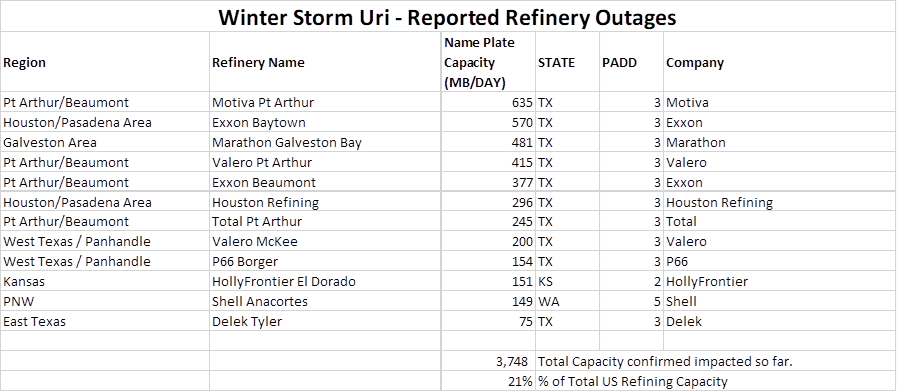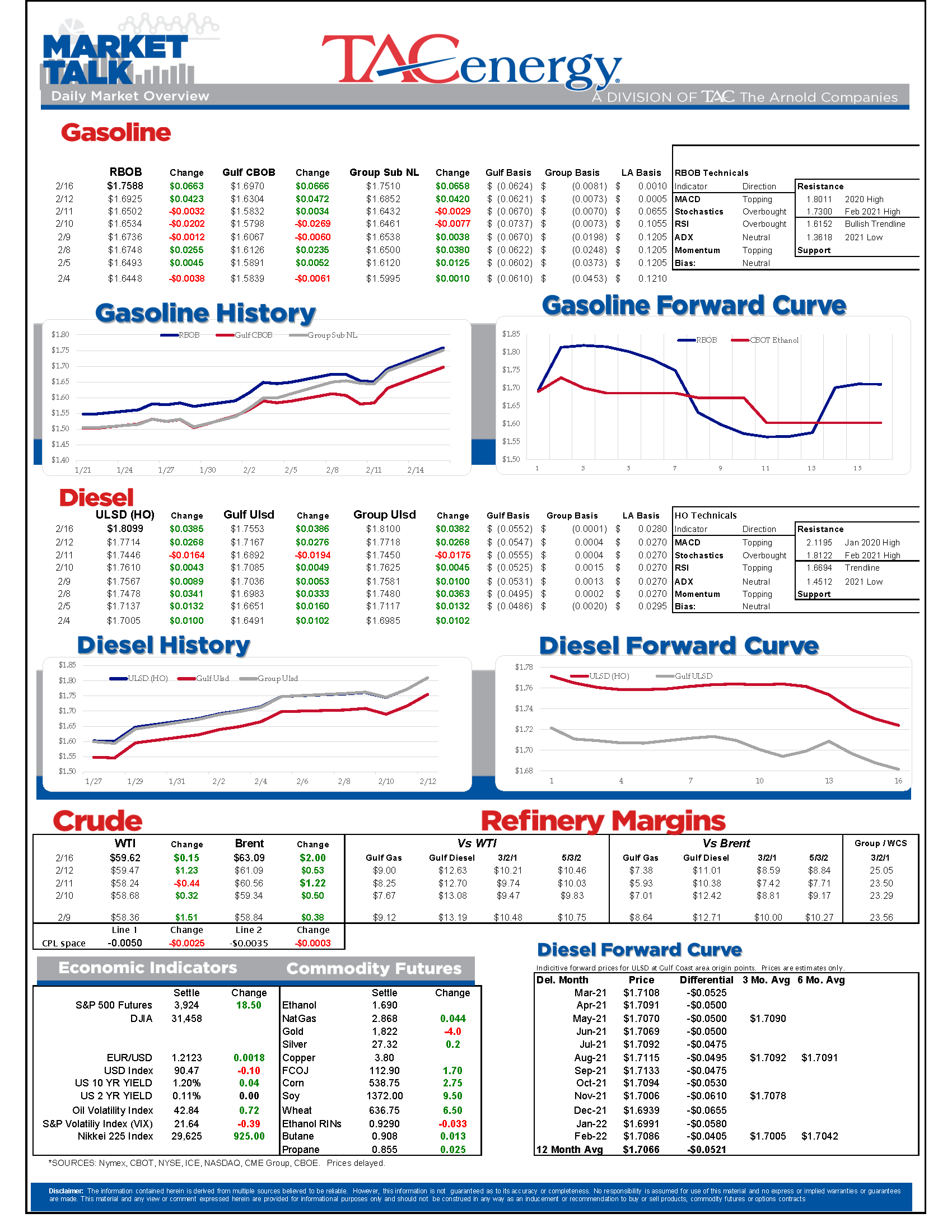Winter Storm Impacts Refinery Production

Refined products are seeing large gains this morning after more than 20% of the country’s refining capacity was forced to shut after most of the country was literally and figuratively frozen by record-setting cold temperatures.
This winter storm is now rivalling Hurricane Harvey for its impact on refinery production, and may well surpass that storm when all is done as another day of cold & snow is forecast before things start to warm up. The impacts of this storm are much more widespread, with refining disruptions in PADDs 2, 3 and 5 all reported so far as power outages stretch from the West Coast to the Gulf Coast and now to the East Coast.
The list below details the plants that are said to be shutting down until power and temperatures stabilize. Note that so far the Louisiana refineries seem to have missed the worst of the cold and are continuing to run, whereas most plants surrounding Houston area are having to cut back.
In addition to the refinery disruptions, Explorer pipeline was forced to shut operations due to power problems around Houston, and is expected to attempt a restart Wednesday. So far Colonial pipeline operations are said to be continuing as normal, which is critical to keep this even from causing localized supply shortages to widespread outages.
RBOB gasoline futures were up by 10 cents in overnight trade, but have pulled back to “only” up seven cents this morning, while diesel prices are up around four cents. It’s worth noting that RBOB futures came within a penny of the high trade set last January in the wake of Iran’s attack on U.S. troops, which creates a big resistance layer on the charts right around the $1.80 mark. If knocking 1/5th of the country’s refining capacity offline isn’t enough to break that resistance, we could see this as a major selling opportunity and prices could easily pull back 25-30 cents in the next several weeks.
Another thing that’s probably keeping the price rally from picking up too much steam in the early going is that large portions of the population are hunkering down indoors and avoiding the roads for a few days, which is creating huge spikes for electricity and natural gas demand, but is probably doing the exact opposite for gasoline consumption.
Similar to what we saw during the record-setting hurricane season in 2020, the reduced demand and excess refining capacity sitting idle caused by COVID seems to be acting as a buffer against a more dramatic spike in prices. It will probably be another couple of days before damage assessments can be done, but with warmer temperatures ahead, there’s a good chance most of these refineries will be starting back up before the weekend.
Crude oil futures rallied north of $60 Monday after one million barrels/day of production was expected to close due to the storm, but are giving back most of those gains this morning as three million barrels/day of crude oil demand is temporarily off-line due to the rash of refinery closures.
Today’s interesting read: Cleaning up after a 150 year old refinery.
Click here to download a PDF of today's TACenergy Market Talk.
Latest Posts
Energy Markets Rally Again Thursday After A Choppy Wednesday Session
Week 16 - US DOE Inventory Recap
Energy Markets Trading Quietly In The Red As Ethanol Prices Rally To Five-Month High
The Struggle For Renewable Producers Continues As A Rapid Influx Of Supply And Crashing Credit Prices Make Biodiesel
Social Media
News & Views
View All
Energy Markets Rally Again Thursday After A Choppy Wednesday Session
Energy markets are trying to rally again Thursday after a choppy Wednesday session. RBOB gasoline futures are leading the push higher, on pace for a 3rd consecutive day of gains after finding a temporary floor Tuesday and have added 12 cents from those lows.
Equity markets are pointing sharply lower after a weak Q1 GDP estimate which seems to have contributed to a pullback in product prices over the past few minutes, but don’t be surprised if the “bad news is good news” low interest rate junkies start jumping in later on.
The DOE’s weekly report showed sluggish demand for gasoline and diesel, but inventory levels in most markets continue to follow their typical seasonal trends. Refinery runs held fairly steady last week with crude inputs down slightly but total gross throughputs up slightly as most facilities are now back online from a busy spring maintenance season and geared up for peak demand this summer.
Propane and propylene exports spiked to a record high north of 2.3 million barrels/day last week, which demonstrates both the US’s growing influence on global product markets, and the steady shift towards “other” products besides traditional gasoline and diesel in the level of importance for refiners.
The EIA acknowledged this morning that its weak diesel consumption estimates reflected the switch to Renewable Diesel on the West Coast, although they did not provide any timeline for when that data will be included in the weekly survey. The agency acknowledged that more than 4% of the total US consumption is now a combination of RD and Biodiesel, and that number is expected to continue to grow this year. This morning’s note also suggested that weak manufacturing activity was to blame for the sluggish diesel demand across the US, while other reports suggest the freight recession continued through Q1 of this year, which is also contributing to the big shift from tight diesel markets to oversupplied in several regions.
Valero kicked off the Q1 earnings releases for refiners with solid net income of $1.2 billion that’s a far cry from the spectacular earnings north of $3 billion in the first quarter of 2023. The refining sector made $1.7 billion, down from $4.1 billion last year. That is a pattern that should be expected from other refiners as well as the industry returns to a more normal market after 2 unbelievable years. You wouldn’t guess it by looking at stock prices for refiners though, as they continue to trade near record highs despite the more modest earnings.
Another pattern we’re likely to see continue with other refiners is that Renewable earnings were down, despite a big increase in production as lower subsidies like RINs and LCFS credit values sting producers that rely on those to compete with traditional products. Valero’s SAF conversion project at its Diamond Green joint venture is progressing ahead of schedule and will give the company optionality to flip between RD and SAF depending on how the economics of those two products shakes out this year. Valero also shows part of why refiners continue to disappear in California, with operating expenses for its West Coast segment nearly 2X that of the other regions it operates in.

Week 16 - US DOE Inventory Recap

Energy Markets Trading Quietly In The Red As Ethanol Prices Rally To Five-Month High
Energy markets are trading quietly in the red to start Wednesday’s session after a healthy bounce Tuesday afternoon suggested the Israel-Iran-linked liquidation had finally run its course.
There are reports of more Ukrainian strikes on Russian energy assets overnight, but the sources are sketchy so far, and the market doesn’t seem to be reacting as if this is legitimate news.
Ethanol prices have rallied to a 5-month high this week as corn and other grain prices have rallied after the latest crop progress update highlighted risks to farmers this year, lower grain export expectations from Ukraine, and the approval of E15 blends this summer despite the fact it pollutes more. The rally in grain and renewables prices has also helped RIN values find a bid after it looked like they were about to test their 4-year lows last week.
The API reported small changes in refined product inventories last week, with gasoline stocks down about 600,000, while distillates were up 724,000. Crude oil inventories increased by 3.2 million barrels according to the industry-group estimates. The DOE’s weekly report is due out at its normal time this morning.
Total reported another upset at its Port Arthur refinery that’s been a frequent flier on the TCEQ alerts since the January deep freeze knocked it offline and damaged multiple operating units. This latest upset seems minor as the un-named unit impacted was returned to normal operations in under an hour. Gulf Coast basis markets have shrugged off most reports of refinery upsets this year as the region remains well supplied, and it’s unlikely we’ll see any impact from this news.
California conversely reacted in a big way to reports of an upset at Chevron’s El Segundo refinery outside of LA, with CARBOB basis values jumping by more than a dime. Energy News Today continued to show its value by reporting the upset before the flaring notice was even reported to area regulators, proving once again it’s ahead of the curve on refinery-related events. Another industry news outlet meanwhile struggled just to remember where the country’s largest diesel seller is located.
Click here to download a PDF of today's TACenergy Market Talk

